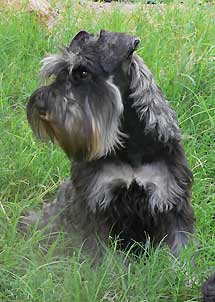Breed Type
Utility / Terrier
History
Miniature Schnauzers are the smallest of the three Schnauzer varieties, the other two being Standards and Giants. All share a common heritage from 15th century Germany, where they were initially bred as a farmer's helper to herd sheep, guard the farm and keep vermin in control by catching rats and mice. However, in the late 1800's the 3 separate varieties emerged. The "Miniature" was created by crossing this ancestral Schnauzer with Affenpinschers, and possibly Miniature Pinschers and Poodles. These smaller dogs were more suited for rodent control in smaller households, and it is also where they developed their great companion qualities.
Description
Small, but quite squarely built and muscular dog, with an alert expression, black nose, dark oval shaped eyes and small V-shaped ears set high on the skull, and dropping forwards neatly onto the head. Some countries permit ear cropping and tail docking. The soft undercoat can be a different colour to the wiry topcoat, giving rise to their most common colour pattern - Salt & Pepper. They also come in Black & Silver, solid Black, and solid White.
Size
30-36 cm (12-14 inches) at the shoulder, and 5-7 kg (11-15 pounds).
Coat
A wiry coat that is generally kept trimmed into a very handsome style, highlighting long, bushy eyebrows and beard, with a short body coat and fluffy leg furnishings. The coat does not fall out in a natural moult, so will also need to be clipped or stripped out every few months. At a minimum, the coat will also need weekly brushing, but probably a little more often to keep it in good condition.
Temperament
Mini Schnauzers are wonderfully spirited, inquisitive and energetic dogs, with cheeky yet thoroughly affectionate and loyal natures. They bring fun to any household. It is important however that they are well socialised when they are puppies, as they have some potential to be a little dog aggressive and somewhat wary of strangers.
Longevity
Ranging from 12 - 15 years.
Health
Generally a healthy breed, but can be somewhat prone to dental problems and obesity related health issues if not managed properly. They will not thrive if denied the companionship they have been bred for.
Possible Genetic Disorders
Miniature Schnauzers have the potential in some genetic lines to be prone to Urolithiasis, Hyperlipidemia and Pancreatitis, as well as the eye diseases Progressive Retinal Atrophy (PRA) and Cataracts. They can also be somewhat prone to Portosystemic Shunts (PSS) and Schnauzer Bumps. Health screening for PRA and Cataracts is available, and should form part of any discussion when considering a purchase, and although no screening is available for the other disorders, reputable breeders should not breed with affected dogs, and should be happy to discuss the health background of your puppy's parents with you.
Best Suited
- Apartment, house or country
- Household with plenty of human contact
- Household with older children
- Household with retirees
- Allergy sufferers
Worst Suited
- Households with very young children
Recommended Reading 
Getting to Know Miniature Schnauzers: A Guide to Choosing and Owning a Miniature Schnauzers. Author: Cathy Lambert




